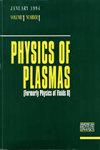Mining experimental magnetized liner inertial fusion data: Trends in stagnation morphology
IF 2.2
3区 物理与天体物理
Q3 PHYSICS, FLUIDS & PLASMAS
引用次数: 0
Abstract
In magnetized liner inertial fusion (MagLIF), a cylindrical liner filled with fusion fuel is imploded with the goal of producing a one-dimensional plasma column at thermonuclear conditions. However, structures attributed to three-dimensional effects are observed in self-emission x-ray images. Despite this, the impact of many experimental inputs on the column morphology has not been characterized. We demonstrate the use of a linear regression analysis to explore correlations between morphology and a wide variety of experimental inputs across 57 MagLIF experiments. Results indicate the possibility of several unexplored effects. For example, we demonstrate that increasing the initial magnetic field correlates with improved stability. Although intuitively expected, this has never been quantitatively assessed in integrated MagLIF experiments. We also demonstrate that azimuthal drive asymmetries resulting from the geometry of the “current return can” appear to measurably impact the morphology. In conjunction with several counterintuitive null results, we expect the observed correlations will encourage further experimental, theoretical, and simulation-based studies. Finally, we note that the method used in this work is general and may be applied to explore not only correlations between input conditions and morphology but also with other experimentally measured quantities.挖掘磁化衬垫惯性聚变实验数据:停滞形态趋势
在磁化衬垫惯性聚变(MagLIF)中,充满聚变燃料的圆柱形衬垫被内爆,目的是在热核条件下产生一维等离子体柱。然而,在自发射 X 射线图像中可以观察到归因于三维效应的结构。尽管如此,许多实验输入对等离子体柱形态的影响还没有得到表征。我们展示了如何使用线性回归分析来探索 57 次 MagLIF 实验中形态与各种实验输入之间的相关性。结果表明可能存在几种尚未探索的效应。例如,我们证明增加初始磁场与提高稳定性相关。虽然这是直观预期的结果,但在综合 MagLIF 实验中从未进行过定量评估。我们还证明,"电流回流 "的几何形状导致的方位驱动不对称似乎对形态产生了可测量的影响。结合几个反直觉的无效结果,我们希望观察到的相关性将鼓励进一步的实验、理论和模拟研究。最后,我们指出,这项工作中使用的方法是通用的,不仅可用于探索输入条件与形态之间的相关性,还可用于探索与其他实验测量量之间的相关性。
本文章由计算机程序翻译,如有差异,请以英文原文为准。
求助全文
约1分钟内获得全文
求助全文
来源期刊

Physics of Plasmas
物理-物理:流体与等离子体
CiteScore
4.10
自引率
22.70%
发文量
653
审稿时长
2.5 months
期刊介绍:
Physics of Plasmas (PoP), published by AIP Publishing in cooperation with the APS Division of Plasma Physics, is committed to the publication of original research in all areas of experimental and theoretical plasma physics. PoP publishes comprehensive and in-depth review manuscripts covering important areas of study and Special Topics highlighting new and cutting-edge developments in plasma physics. Every year a special issue publishes the invited and review papers from the most recent meeting of the APS Division of Plasma Physics. PoP covers a broad range of important research in this dynamic field, including:
-Basic plasma phenomena, waves, instabilities
-Nonlinear phenomena, turbulence, transport
-Magnetically confined plasmas, heating, confinement
-Inertially confined plasmas, high-energy density plasma science, warm dense matter
-Ionospheric, solar-system, and astrophysical plasmas
-Lasers, particle beams, accelerators, radiation generation
-Radiation emission, absorption, and transport
-Low-temperature plasmas, plasma applications, plasma sources, sheaths
-Dusty plasmas
 求助内容:
求助内容: 应助结果提醒方式:
应助结果提醒方式:


